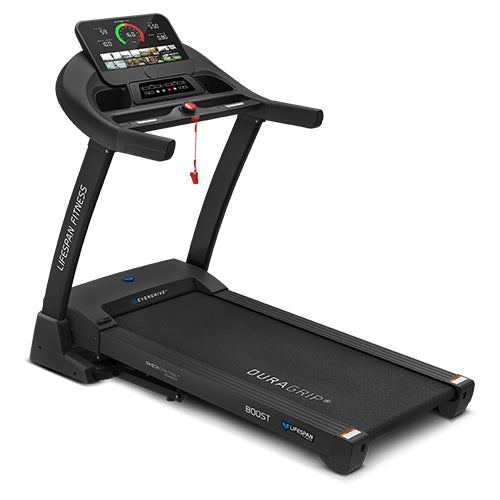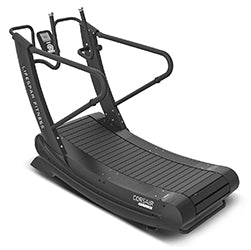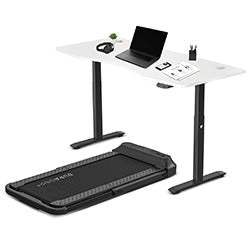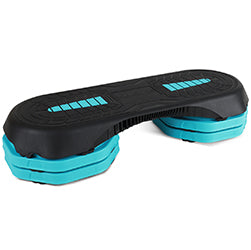Transcript
Hi guys, Peter Day here from Lifespan Fitness. Today we’re going go through some of the key features and differences in our spin bike range to help take the hard work out of buying your first spin bike. Buying your first spin bike can be overwhelming when you’ve got chain vs. belt drivetrains, magnetic vs. friction resistance, different sized flywheels and and a whole range more. But we're going to make it nice and easy for you.
Magnetic Resistance vs. Friction Resistance
Spin bikes use two types of resistance; magnetic or friction. These can be easily identified within the Lifespan Fitness spin bike range by the SP series for friction and the SM series for magnetic resistance.
Friction resistance uses felt pads that rub against the wall of the flywheel which helps create resistance. The main bonus of the felt pads is that they can be tightened all the way to a complete stop. This provides unlimited resistance giving riders the ability to complete high intensity hill climbs and instant resistant changes during fast paced spin sessions. The friction produced from the pads rubbing against the wheel can also cause some noise depending on the speed of the wheel. If you’re a regular rider then the felt pads will require lubrication and will need to be replaced when they wear out.
Magnetic resistance on the other hand is practically silent since there is no friction. This type of resistance uses magnets that sit close to the flywheel but don’t actually touch the wheel. Unlike friction, magnetic has limited resistance, the magnets will reach the flywheel to a certain point before they stop.
Adjusting the resistance is easy, most bikes will have a resistance dial simply twist to your desired intensity. The SM-100 series on the other hand has pre-set levels from 1 through to 8.
If you are after a spin bike that closely resembles a road bike then friction resistance may be for you. As you're using the bike when you change the resistance you can feel it instantly and it really feels you are on a road bike. Otherwise, if you are after a quieter indoor bike with no maintenance then the magnetic resistance bike is for you.
Belt Drivetrain vs. Chain Drivetrain
Within the flywheel there are two different types of drivetrains; chain and belt. A chain drive is similar to an outdoor riding bike and gives a more realistic cycling experience. Chain drives will produce some noise while pedalling, the faster the pedalling, the more noise generated. The chain itself is built up of many metal components meaning it's not as smooth compared to a belt drive.
On the other hand, the belt drive will give a smoother rotation while pedalling, this is because the belt is both rubber and in one piece keeping it consistent all round. Another upside to the belt drive is that it is completely silent, no matter how fast or slow you pedal.
A belt drive doesn’t require any maintenance or replacement however, a chain drive will require lubrication from time to time.
If you are after a quieter bike or live in an apartment and are conscious about neighbors then I would recommend a belt drive for a completely silent ride. Otherwise, if noise isn’t a concern, then a chain drive is another great option.
Flywheel Spin Bike
What is a Flywheel Spin Bike?
Every spin bike is fitted with a flywheel either at the front drive or the rear drive . As you pedal the flywheel rotates, the speed at which it rotates will depend on the resistance- higher resistance makes the flywheel more difficult to rotate and less resistance is easier pedal.
Flywheels come in a variety of weights from 13kg on the SM-100 series right up to 25kg on the SP-800 series. The flywheel weight affects the momentum of the bike while pedalling, a heavier flywheel is harder to accelerate but it maintains speed and momentum more easily. A lighter flywheel carries less momentum and you’ll find that pedalling is not as consistent.
Note: A good mid range flywheel weight that is suited to most riders would be 18kg. Find our collection of 18kg flywheel spin bike here
Our flywheels are either made from your standard cast iron which you will find on the SP-300 series or carbon steel here in the SP-800 series. Carbon steel has a much more consistent weight distribution and is less prone to rust.
All our flywheels are TrueSpin meaning they are balance tested. Balance testing ensures that’s the wheel is correctly weight distributed which greatly increases axel and bearing life for a smoother ride, it also minimises any flywheel knocking sounds.
Spin Bike Adjustments
All spin bikes have 4-way seat adjustability and angle adjustments for as much comfort as possible for every user. Twist the dial beneath the seat here to move the seat backwards and forwards. Then lift the lever here to move the seat post up and down. Some bikes have SpeedLock which allows you to adjust your seat quickly and easily via a quick release lever while you ride eliminating the need to hop off and adjust. Others have the standard pin lock that requires more time and effort in adjusting, which will work well for users who don’t need to share the bike with others.
Handlebars will vary across models; bigger handlebars will offer inside and outside grip positions. Handlebars can also be adjusted by again lifting the lever here and adjusting up or down. Not all spin bikes have the same handlebar adjustments, if you value proper riding ergonomics, choose the bike with the best adjustability when it comes to the handlebars.
Spin Bike Pedals & Cranks
You’ll find two different types of pedals on our spin bikes, the first being your standard cage pedal or our 2-in-1 pedal compatible with Shimano SPD pedal systems. These pedals have an easy clip-on design, allowing riders to easily clip their cleats onto the pedal for a more realistic riding experience. Crank arms will also vary across different models, basic models will have your standard strength crank arm whereas higher end models come with reinforced crank arms. If you are looking to do hill climbs, sprints or any high-powered activity where you’ll be pushing hard on the pedals opt for the stronger crank.
Spin Bike Frame
All our spin bike frames are built with tubular steel, which vary in strength and stability. A stronger frame will reduce the left to right wobble you get from rigorous pedalling. Bigger bikes will have a stronger frame offering more stability and support for taller and bigger users.
Spin Bike Seat
Seats are an important component that often gets overlooked. If you are looking to do seated sprints and long-distance riding then you need a comfortable and well padded seat. Otherwise, riders who complete hill climbs and standing sprints will rarely use the seat, in this case the seat is not as crucial. All spin bikes are fitted with racing seats, the higher end models have extra padding. Both styles offer less interruptions for your standard sprints and are comfortable to sit on.
Spin Bike Display Screen
All spin bikes are fitted with an LCD display screen to help keep track of your workout progress. Data including time, speed, distance and calories will be available on all spin bikes. RPM and pulse reading is available on higher end models like the SM-800 series and SM-700 series. Be sure to check out the workout readouts so you’ll know how hard you’re working!
All Lifespan Fitness models will have Transport wheels, and floor levellers to help you adapt and adjust your bike to your room. Most of them will also come with bottle holders too.
Be sure to check out your workout stats during and after your workout so you know how hard you're working. There you have it, the Lifespan Fitness spin bike range with all the features and comparisons between a whole range of the models.
Find out more about Spin Bikes here
















































